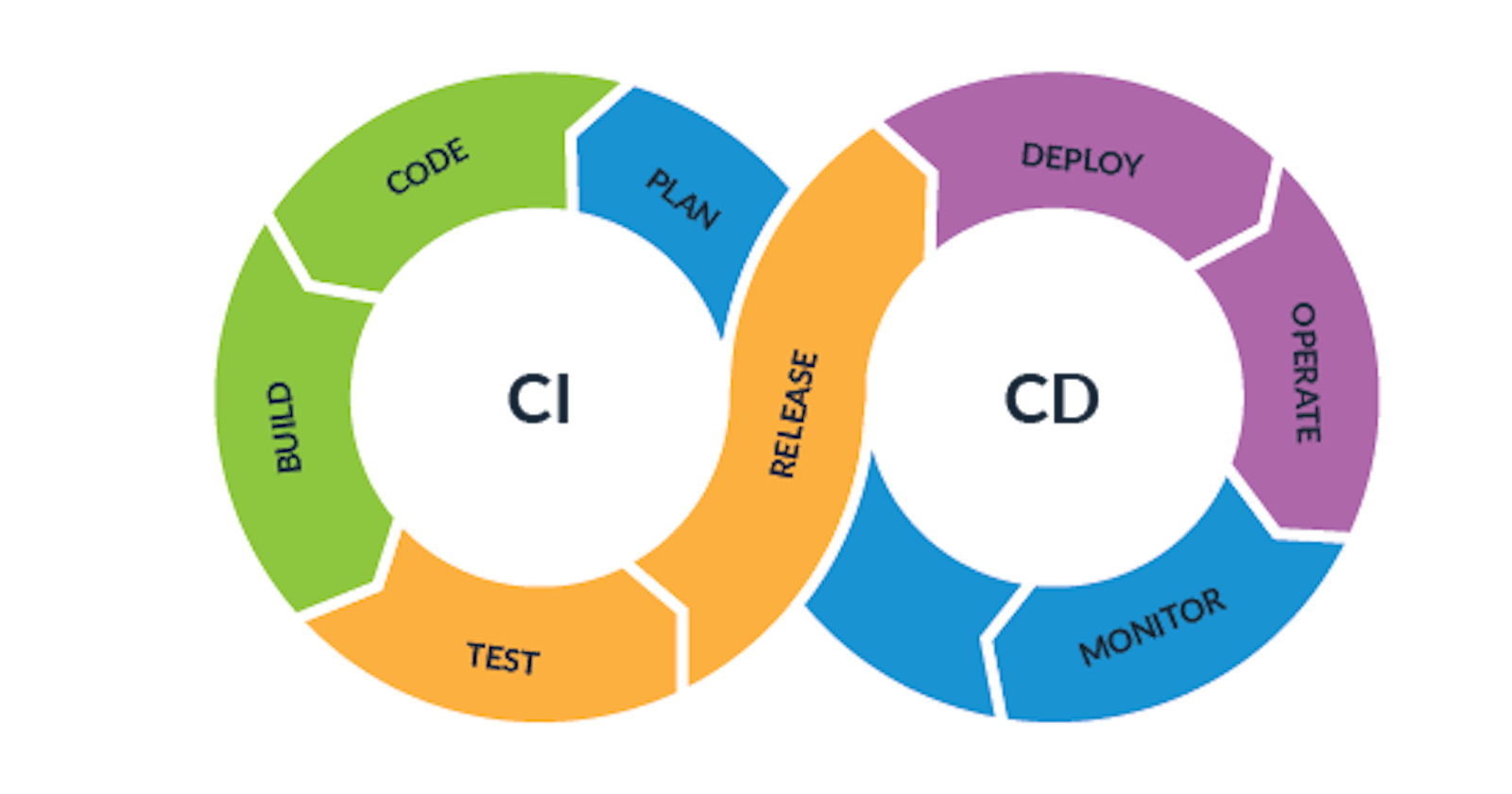Unveiling My Journey into CI/CD
Have you ever encountered a term during a technical interview that left you both intrigued and perplexed? I certainly did when I first heard the acronym "CI/CD" thrown around during an interview with a well-known tech company. At that moment, the term seemed to hover somewhere between familiarity and mystery, leaving me eager to dive deeper into its intricacies. While the interview didn't yield the result I had hoped for, it sparked a curiosity that led me on a journey to uncover the world of Continuous Integration and Continuous Deployment (CI/CD) pipelines.
What is a CI/CD Pipeline?
A CI/CD pipeline is used to automate software or infrastructure-as-code delivery, from source code to production. Think of it as a set of orchestrated steps that guide your code from development to deployment.
- Continuous Integration (CI) covers the build and test stages. With each code change, an automated build and test process kicks off, offering swift feedback to developers.
- Continuous Delivery / Deployment (CD) takes place after testing. Continuous delivery refers to automatically releasing code to a repository, while continuous deployment involves automatically deploying thoroughly tested artifacts.
Stages of a CI/CD Pipeline
A CI/CD pipeline is a structured series of phases that guide software or infrastructure-as-code from its inception to production. Think of it as a well-choreographed dance that seamlessly moves your code through various stages, ensuring quality and efficiency at each step.
Starting with the initial code creation and culminating in the final product reaching end-users, these stages form the heartbeat of the CI/CD pipeline. These stages are set in motion either by automatic triggers from code changes, scheduled intervals, user interaction, or even as a response to a previous pipeline completion.
The core components of a CI/CD pipeline can be broken down as follows:
1) Build
At the inception of the pipeline, developers contribute their code to a shared version control system. This collaboration forms the foundation of your project. To streamline this process, a Git-based workflow often acts as a guiding principle, ensuring that code additions are controlled and structured. In the pipeline context, tools that establish consistent developer environments play a critical role in erasing discrepancies among the authors' contributions. These environments are often encapsulated within Docker containers, a hallmark of cloud-native development.
2) Test
As the project grows and becomes more complex, ensuring its reliability becomes paramount. This is where the testing phase takes center stage. Automated testing emerges as a powerful ally, relieving developers of repetitive tasks and reducing the likelihood of human error. Different types of tests combine forces with diverse tools to maximize code coverage and enhance product quality:
- Smoke Testing: Quick checks to ensure fundamental functionality.
- Integration Testing: Safeguards against new code breaking existing components.
- Unit Testing: Focused tests on specific functions or segments, often parallelized for faster feedback.
- Compliance Testing: Guarantees adherence to predefined project policies.
- End-to-End Testing (E2E): Holistic tests to ensure the complete process functions cohesively.
3) Deliver
With code thoroughly tested and polished, it's time to prepare it for its next destination. This phase involves packaging the code into a coherent and deployable artifact, ready to be released.
4) Deploy
The climax of the pipeline is the deployment phase, where the orchestrated release of the artifact takes place. In the real world, teams deploy their creations to various environments, including development, staging, and production. This strategy allows for seamless transitions and thorough checks before code is finally rolled out to end-users. Automation shines in this phase, where staging deployments are triggered automatically, with main-branch merges and subsequent production deployments following a predefined path.
CI/CD Pipeline Benefits
The adoption of CI/CD pipelines offers a wealth of advantages that ripple through the software development landscape, as highlighted by these key benefits:
- Cost Reduction
The integration of CI/CD pipelines isn't just about technical enhancement; it's about optimizing resources. By slashing the time required for coding and deployment, these pipelines alleviate the burden on human resources, leading to significant cost reductions. This streamlined efficiency not only accelerates the development cycle but also ensures prudent resource allocation. - Faster Deployment Times
The magic of automation transforms the trajectory of deployment. The entire journey, spanning code inception to its final destination, undergoes a metamorphosis that trims unnecessary delays. This acceleration isn't solely about speed; it encapsulates an enhanced overall efficiency. Additionally, the capacity for frequent deployments grants companies a competitive edge. The safety net of easy rollback in case of issues ensures that developers remain undistracted. - Empowering Continuous Feedback
The beating heart of improvement lies in continuous feedback, and this is precisely what CI/CD pipelines provide. The testing phase stands as a beacon, flagging concerns and furnishing rapid feedback. This empowers development teams to iterate and amplify code enhancements at a pace previously unimaginable. By unearthing errors early in the coding journey, developers embark on swift rectifications. Automated notifications serve as the harbingers of progress and hurdles, facilitating nimble adaptations. - Strengthening Team Collaboration
Transparency emerges as a cornerstone of seamless teamwork within the realm of CI/CD pipelines. These pipelines unravel the intricacies of the process, offering team members a window into challenges and feedback. This newfound transparency fosters an environment where insights drive changes, nurturing a culture of collaborative innovation. - Tracing Digital Trails
The principles of accountability and traceability find a digital embodiment within CI/CD pipelines. At each phase, meticulous logs are generated, charting a comprehensive journey. This digital trail ensures that every action is well-documented, paving the way for accountability and thorough audits when the need arises.
What Makes a Good CI/CD Pipeline?
Ultimately, the essence of implementing a CI/CD pipeline lies in its ability to provide rapid, precise, reliable, and comprehensive feedback throughout the development lifecycle. To ensure an effective pipeline, it's essential to address these core factors: speed, accuracy, reliability, and comprehensiveness.
- Speed: A Need for Swift Responsiveness
The foundation of continuous integration is swift responsiveness and immediate feedback. A critical threshold is crossed if developers are left waiting for over 10 minutes for their builds to be verified in the QA environment. This delay disrupts the workflow, compelling developers to shift contexts and wait for one build to complete before progressing to the next.
In the context of a CI/CD pipeline, the time taken for each commit directly impacts the frequency of code deployments within a day. The modern business landscape demands rapid updates and agile adaptation to changes. Thus, the CI/CD process should seamlessly align with this dynamic workflow.
Moreover, as businesses expand, the CI/CD tools must scale in tandem to meet evolving demands. The power of a tool lies in its programmability and compatibility with existing development workflows. Storing CI/CD configurations as code allows for review, versioning, and future restoration. - Accuracy: Precision in Automation
Automation is the cornerstone of deployment, but accuracy elevates it to the next level. A functional CI/CD pipeline goes beyond automation; it accurately executes and visualizes the entire software delivery journey. This accuracy is critical when handling both straightforward and intricate workflows, minimizing the potential for manual errors during repetitive tasks.
The journey towards full automation—from continuous integration to continuous deployment—should be seamless, requiring minimal human intervention. - Reliability: The Backbone of Consistency
Reliability in a CI/CD pipeline leads to the swift creation and deployment of new commits. A dependable pipeline ensures consistent output with the same input, without fluctuations in runtime.
As the product team's pace accelerates, the CI/CD infrastructure must maintain its reliability and adaptability. As the number of teams, projects, or workflows expands, the pipeline should effortlessly accommodate the increased workload. - Comprehension: A Holistic Approach
An effective CI/CD pipeline should comprehensively cover all aspects of the software delivery process. The omission of a single phase in the CI/CD tools can ripple through the entire pipeline, impacting its efficacy and the overall development process.
CI/CD Best Practices and Tools
Efficient CI/CD pipelines are underpinned by a set of best practices that streamline development and deployment processes. Moreover, selecting the right tools plays a pivotal role in ensuring the pipeline's effectiveness tailored to your organization's needs.
The road to a well-optimized CI/CD pipeline is paved with best practices that ensure a seamless workflow:
Commit Early and Often: Frequent commits keep the codebase manageable and minimize the risk of complex merge conflicts. This iterative approach facilitates swift identification and resolution of issues.
Make It the Only Way to Deploy to Production: By mandating the CI/CD pipeline as the sole route to production, consistency is maintained, and the likelihood of manual errors is diminished.
Continuously Review Your Automation Processes: Regularly assess and fine-tune your automation processes to stay aligned with evolving development practices and technological advancements.
Speed Up Your Pipeline: Efficiency is the essence of CI/CD. Optimize your pipeline for rapid execution, enabling swift feedback and accelerated deployment cycles.
Monitor Your Pipeline: Vigilant monitoring ensures the health of your pipeline. Promptly address any deviations, bottlenecks, or issues that may arise during the process.
Choosing the right tools for CI/CD is akin to handpicking the gears that drive your development engine. Each tool serves a unique purpose, catering to different facets of the development lifecycle. Here are some prominent tools that span the spectrum of CI/CD orchestration:
- Jenkins: This open-source powerhouse is renowned for its adaptability. Acting as an automation server, Jenkins can seamlessly transition from a CI server to a continuous delivery hub.
- CircleCI: Offering versatile environments and a multitude of pre-built integrations, CircleCI operates both as a cloud-based CI/CD orchestrator and as a platform with self-hosted runners, enhancing flexibility and control.
- GitLab CI/CD: With a focus on streamlining and automating the release process, GitLab provides secure and flexible deployment options. It stands as a unified hub for CI/CD, enabling end-to-end development lifecycle management.
- Travis CI: An open-source platform that expedites code development, testing, and deployment. Its simplicity in setup, coupled with support for over 30 languages, offers considerable adaptability.
- Semaphore: Offering compatibility with various languages and platforms, including iOS apps, Semaphore acts as a catalyst for swift releases across web, desktop, and mobile applications.
- Spinnaker: An open-source continuous delivery platform, Spinnaker partners with various cloud providers to ensure rapid, secure, and repeatable deployments.
From the initial introduction to CI/CD pipelines and their multifaceted stages, to exploring the fundamental principles that underscore their success, we've delved into a realm that redefines the pace and precision of code delivery. We've learned about the benefits that organizations reap by embracing this methodology, streamlining their processes, fostering collaboration, and creating robust accountability.
With a firm understanding of what constitutes a good CI/CD pipeline, we've grasped the importance of speed, accuracy, reliability, and comprehension—the cornerstones of a well-orchestrated system. Moreover, we've unearthed the significance of adhering to best practices that guide us toward a seamless workflow, enabling us to deliver excellence consistently.
Lastly, we've witnessed the array of tools at our disposal to build these pipelines—tools that are not mere additions but the very gears that drive our development engine. These tools are handpicked to align with our needs, offering automation, orchestration, and empowerment on this voyage of code evolution.
As we wrap up this expedition into the realm of CI/CD pipelines, remember that these concepts are not confined to the realm of technology alone. They stand as testaments to the ever-evolving landscape of progress, where agility, collaboration, and precision are the navigational stars that guide us toward innovation.
So, as you continue your own journey in the world of software development, may your CI/CD pipelines be steady, your automation be faultless, and your innovations be boundless. The voyage may be ongoing, but armed with the insights you've gained here, you're well-equipped to navigate the currents of change and steer your projects toward success.
Happy coding, and may your CI/CD pipelines light the path to a brighter technological future!

